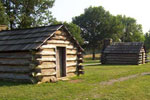Valley Forge Historical Park
Valley Forge in Pennsylvania was the site of the camp of the American Continental Army over the winter of 1777-1778 in the American Revolutionary War.
With winter almost completely setting in, the prospects for campaigning were greatly diminishing, General George Washington sought quarters for his men. Washington and his troops had just fought what was to be the last major engagement of 1777 at the Battle of White Marsh (or Edge Hill).
He devised to pull his troops from their present encampment in the White Marsh area (now Fort Washington State Park) and move to a more secure location for the coming winter. Though several locations were proposed, he selected Valley Forge, Pennsylvania, 18 miles (29 km) northwest of Philadelphia. It proved to be an excellent choice. Named for an iron forge on Valley Creek, the area was close enough to the British to keep their raiding and foraging parties out of the interior of Pennsylvania, yet far enough away to halt the threat of British surprise attacks. The high ground of Mount Joy and the adjoining elevated ground of Mount Misery combined with the Schuylkill River to the north, made the area easily defensible.
On December 19, 1777, when Washington’s poorly fed, ill-equipped army, weary from long marches, struggled into Valley Forge, winds blew as the 12,000 Continentals prepared for winter’s fury. Grounds for brigade encampments were selected, and defense lines were planned and begun. Though construction of more than a thousand huts provided shelter, it did little to offset the critical shortages that continually plagued the army.
The men were under cover within six weeks, and three days. The first properly constructed hut appeared in three days. One other hut, which required 80 logs, and whose timber had to be collected from miles away, went up in one week with the use of only one axe. The men described their lodgings as “cozy and comfortable quarters” and they were proud of the structures they had built. These huts provided sufficient protection from the moderately cold, but mainly wet and damp conditions of the mild, but typical Pennsylvania winter of 1777-78. Snow was limited, and small in amounts. Alternating freezing and melting of snow and ice made it impossible to keep dry and allowed for disease to fester.
Soldiers received irregular supplies of meat and bread, some getting their only nourishment from “fire cake,” a tasteless mixture of flour and water. However, due to the talents of Baker General Christopher Ludwig, the men at Valley Forge more often than not received fresh baked soft bread, about one pound daily. So severe were conditions at times that Washington despaired “that unless some great and capital change suddenly takes place … this Army must inevitably … Starve, dissolve, or disperse, in order to obtain subsistence in the best manner they can.” Animals fared no better. General Henry Knox, Washington’s Chief of Artillery wrote that hundreds of horses either starved to death or died of exhaustion.
The site of the encampment became a Pennsylvania State Park in 1893 and, on the 4th of July, 1976, it became Valley Forge National Historical Park. The modern park features historical and recreated buildings and structures; memorials; and a newly renovated visitor center, which shows a short film and has several exhibits. A chapel was built in 1903 as a memorial to George Washington. An adjoining carillon of 58 bells represents all U.S. states and territories. It resides in a tower built by the Daughters of the American Revolution. Other park amenities include walking and bicycle trails. The park supports around 1000 deer which can be seen grazing in the wide open fields.
